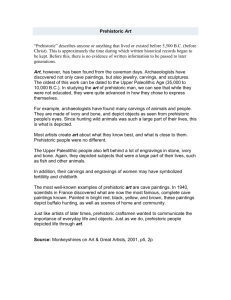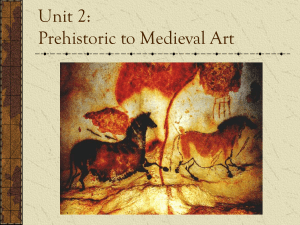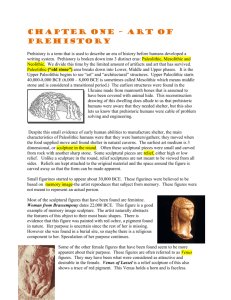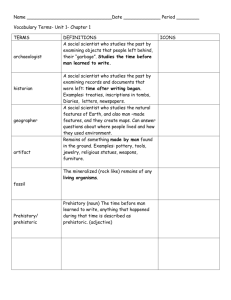Prehistoric Venus, or Ancient Goddess, is a reference
advertisement
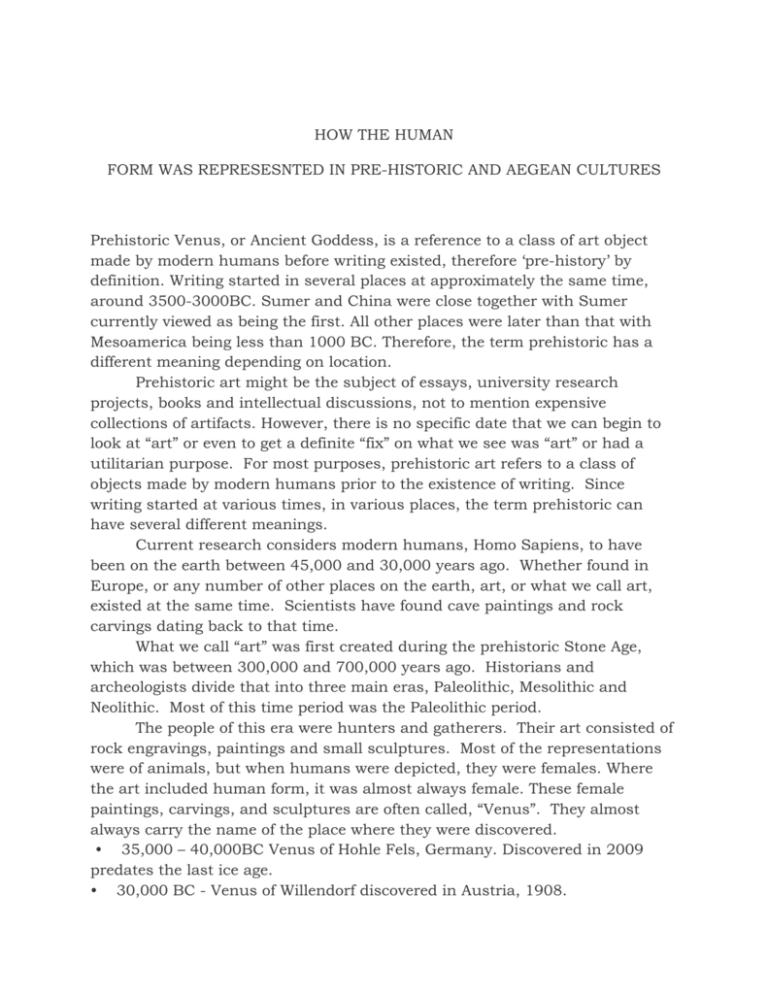
HOW THE HUMAN FORM WAS REPRESESNTED IN PRE-HISTORIC AND AEGEAN CULTURES Prehistoric Venus, or Ancient Goddess, is a reference to a class of art object made by modern humans before writing existed, therefore ‘pre-history’ by definition. Writing started in several places at approximately the same time, around 3500-3000BC. Sumer and China were close together with Sumer currently viewed as being the first. All other places were later than that with Mesoamerica being less than 1000 BC. Therefore, the term prehistoric has a different meaning depending on location. Prehistoric art might be the subject of essays, university research projects, books and intellectual discussions, not to mention expensive collections of artifacts. However, there is no specific date that we can begin to look at “art” or even to get a definite “fix” on what we see was “art” or had a utilitarian purpose. For most purposes, prehistoric art refers to a class of objects made by modern humans prior to the existence of writing. Since writing started at various times, in various places, the term prehistoric can have several different meanings. Current research considers modern humans, Homo Sapiens, to have been on the earth between 45,000 and 30,000 years ago. Whether found in Europe, or any number of other places on the earth, art, or what we call art, existed at the same time. Scientists have found cave paintings and rock carvings dating back to that time. What we call “art” was first created during the prehistoric Stone Age, which was between 300,000 and 700,000 years ago. Historians and archeologists divide that into three main eras, Paleolithic, Mesolithic and Neolithic. Most of this time period was the Paleolithic period. The people of this era were hunters and gatherers. Their art consisted of rock engravings, paintings and small sculptures. Most of the representations were of animals, but when humans were depicted, they were females. Where the art included human form, it was almost always female. These female paintings, carvings, and sculptures are often called, “Venus”. They almost always carry the name of the place where they were discovered. • 35,000 – 40,000BC Venus of Hohle Fels, Germany. Discovered in 2009 predates the last ice age. • 30,000 BC - Venus of Willendorf discovered in Austria, 1908. • 25,000 BC – Venus of Lespuge discovered in a French cave in 1922. • 23,000 BC – Venus of Brassempouy discovered in 1894 in Brassempouy, Landes, France. • 20,000 BC – Venus of Laussel discovered in 1911 in a cave in Dordogne, France. These females were nudes. Often these were plump female figures with aggressive sexual characteristics. The forms were not necessarily proportional, and sometimes did not have a normal face, or even a human head. The breasts and genitalia were disproportionately large, and if there were a head on the figure, it was often small. But the bodies of the forms were almost always obviously female. The people in the prehistoric era became less nomadic they changed from food gatherers to food producers. Their refined weapons and tolls not only were used to dig and hunt but were also used more to create sculpture and different types of art. The female figures were created as statuettes and clay figures which may have even been baked. The Aegean (Cyclades and Minoan) cultures created mostly animal pictures with paint and carvings in stone and rock. The same theme appeared in theses cultures as in the other prehistoric art—female figures were prominent. A recurring theme of high stylized female nudes, almost abstract, seemed to represent a sort of “goddess” to the people. The face was sometimes just an oval, without any realistic features. The Cyclades are a group of islands in the Aegean Sea. Many of the islands have mineral resources such as gold, silver and marble. Evidence points to Neolithic settlements on some of the islands. The settlers were at first fishermen and grew a few grains. They were good sculptors in both marble and various kinds of stone. Early sculptures were mostly female figures, some with natural proportions and some were more abstract. Various materials were used in creating the sculptures, and then they sometimes were painted to apparently make them more “life like.” It is obviously that during this prehistoric era, the female form was the human form chosen in the creation of art. Obviously this was not “art for art’s sake”, but served a more spiritual purpose, or something even deeper than that. Unfortunately, since there was no writing, we will never know the exact meaning or meanings of the human forms found these thousands of years after their creation. But, maybe we can call these figures “art” in any case. Art is what inspires us, motivates us, sets our mood, and tells who we are as a people. Whatever our prehistoric ancestors had in mind, we can surely call these human figures art now.

